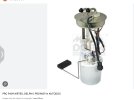I have the fuel tank out on my 1990 Discovery 1 3.5 carburettor model to get at chassis for welding. The fuel pump on the top at least looks pretty bad and the connections were difficult to release. I’m thinking to change the pump while it’s out there is a confusing picture on possible replacements. Best as I can find out the correct pump is part number PRC7129 which is rather expensive, around £150 to £175. Some of the aftermarket suppliers Britpart pumps for Discovery 1 which are a lot cheaper, around £70, and they looked exactly the same except for the electrical connection, the one I have is a cable coming out of it whereas other ones have a socket for a cable to plug in. Pump and send the unit are simple wiring so I’m sure a conversion is possible.
The body had the experience of replacing one of these pumps with non-standard near so what did you use please?
Pictures of existing pump below the minor


The body had the experience of replacing one of these pumps with non-standard near so what did you use please?
Pictures of existing pump below the minor

